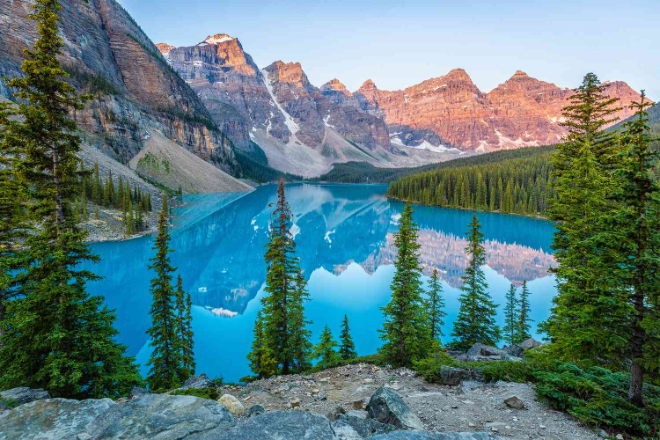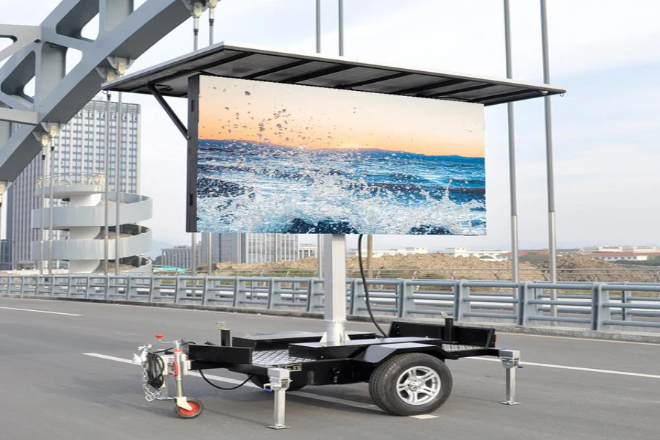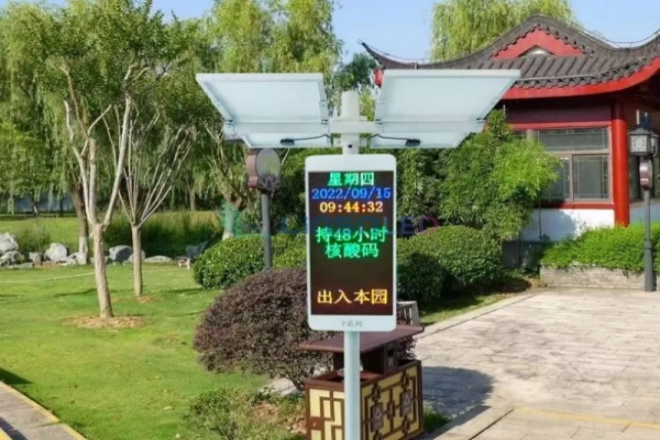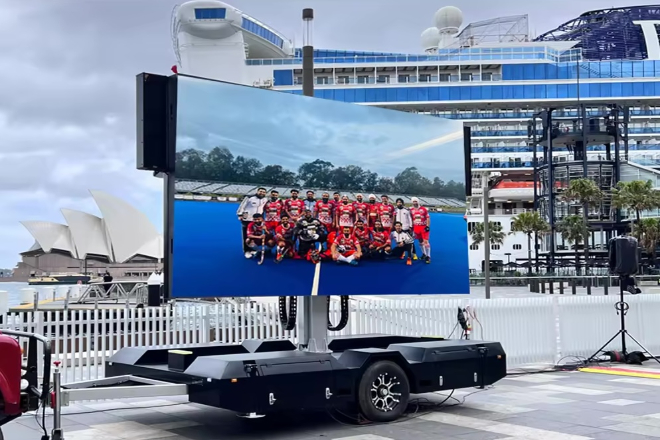Introduction
In a picturesque scenic spot, how can we achieve a perfect fusion of environmental protection and technology? Solar LED displays may be an excellent choice. But is this equipment really suitable for use in scenic spots?
Table des matières
1. Analyze the environmental characteristics and energy needs of scenic spots.

Most scenic spots are in remote places, such as mountainous areas and islands. The scenery is beautiful, but it is troublesome to access electricity.
It is costly to pull traditional wires over, and they are easy to break. Once they age, there will be power outages, which is a headache.
There is a lot of equipment in the scenic spot that needs electricity, such as lighting, signboards, billboards, and catering and accommodation places. The demand for electricity is quite large.
However, scenic spots now pay attention to environmental protection and want to use new energy to reduce dependence on traditional energy. Solar energy and wind energy are good.
However, new energy equipment must be able to adapt to the environment of the scenic spot, such as humid and windy places.
The equipment must be durable and not destroy the landscape; otherwise, it is not suitable.
2. A brief introduction to solar LED displays

Solar LED displays are devices that combine solar power generation technology with LED display technology.
It converts light energy into electrical energy through solar panels, stores the electrical energy in batteries, and then uses this electrical energy to drive the LED display.
This device is particularly suitable for places where there is no stable power supply, or energy conservation is required, such as remote areas, outdoor scenic spots, rural areas, etc.
Advantages of solar LED display:
The solar LED display is like a “green expert”. It relies on solar panels to convert sunlight into electricity without burning coal or oil and without any pollution.
Moreover, LED displays are particularly energy-saving and use much less electricity than ordinary displays.
For example, an ordinary display may consume several kilowatt-hours of electricity a day, but a solar LED display may only need a fraction of the electricity to light up.
Using it not only protects the environment but also saves a lot of electricity bills, killing two birds with one stone.
Although it may cost some money to install a solar LED display at the beginning, it is super cost-effective to use later.
It does not need to be connected to the power grid, there is no electricity bill, and you don’t have to worry about the electricity bill for ten or eight years.
Moreover, this thing has a simple structure and rarely needs to be repaired.
Solar panels and LED displays are very durable and can be used for more than ten years without any problem, unlike some equipment that needs to be replaced after a short time.
In the long run, it can save a lot of money.
Solar LED displays are very flexible. As long as there is sunlight, you can install it anywhere.
For example, in a scenic area, you can put it on the top of a mountain, by the lake, or in the woods without having to consider whether there are wires.
If you want to move to another place, just take it down and move it to another position. Unlike traditional displays, you have to pull wires again, which is very troublesome.
Solar LED displays generate and store electricity by themselves and are completely independent of the power grid.
Even if there is a power outage outside, as long as there is sunlight, it can work normally.
For example, at a traffic intersection, it can continue to display traffic information during a power outage, which will not delay everyone’s travel.
Moreover, it has an intelligent system that can automatically manage electricity so that electricity can be used longer and the equipment is more durable.
The solar LED display screen is small and beautiful and will not look obtrusive like a traditional large billboard.
When placed in a scenic area, it can perfectly blend with the surrounding natural environment and will not damage the scenery.
For example, a park can be designed to be the same colour as flowers, plants, and trees, which can display information without looking obtrusive and can also add points to the environment.
3. Advantages and disadvantages of using solar LED display screens in scenic spots

1). Avantages
1.1). Significant environmental benefits
The use of solar LED display screens in scenic spots has a particularly good environmental protection effect.
It relies on solar energy to generate electricity, does not burn oil, consumes no electricity, and has no carbon emissions, which is particularly in line with the goal of ecological construction in scenic spots.
Moreover, it is pollution-free, unlike traditional power equipment, which may have noise or electromagnetic interference.
Scenic spots originally relied on natural scenery to attract people. Using this environmentally friendly equipment can better protect the environment and allow tourists to enjoy the true beauty of nature here.
1.2). Economic cost analysis
Although it costs a lot of money to install a solar LED display screen at the beginning, it can save a lot in the long run.
It does not need to be connected to the power grid, so there is no electricity bill, and you don’t have to worry about electricity bills for more than ten years.
Moreover, it does not need to maintain the line frequently like traditional power equipment, which saves a lot of trouble and cost.
In the end, although the initial investment of using a solar LED display screen is high, it can save a lot of money later, and the cost performance is very high.
1.3). Improve the image of scenic spots
The scenic spot uses solar LED display screens to show its attention to environmental protection, which is particularly important now.
Nowadays, many tourists pay attention to environmental protection. Seeing that the scenic spot uses such advanced equipment, they will feel that the scenic spot is very responsible and will be more willing to come and play.
Moreover, this modern equipment can also make the scenic spot look more technological, improve the overall management level of the scenic spot, and make tourists feel that the scenic spot is very attentive.
2). Inconvénients
2.1). Affected by the weather
The biggest problem with solar LED display screens is that they rely on the sun. If there are continuous cloudy or rainy days, the solar panels will not be able to generate electricity, and the display screen may be out of power.
Although the battery can store electricity, if there is no sun for several consecutive days and the electricity is used up, the display screen will “strike”.
For example, in some rainy mountain scenic spots, this situation is more common and may affect the normal use of the display screen.
2.2). The installation location is limited
It needs to be installed in a sunny place without any obstruction. If there are too many trees in the scenic area or the building blocks of sunlight, the solar panel will not be able to work properly.
For example, in some ancient architectural scenic spots, in order to protect cultural relics, trees cannot be cut down, or the building layout cannot be changed at will, which makes it difficult to find a suitable place to install solar panels.
4. So, can solar LED display screens be used in scenic spots?

Of course! Scenic spots can use solar LED display screens, but in actual applications, the following key points should be noted:
1). Installation location
Choosing a place is very important! Solar LED display screens are charged by sunlight, so you have to find a sunny place, such as an open area, a mountain top or a lakeside in a scenic area.
These places have long direct sunlight, so the solar panels can be charged enough.
If it is installed under the shade of a tree or blocked by a building, the solar panel will not be “full”, and the display screen may be out of power.
In addition, the installation place should be stable so as not to be blown down by the wind or accidentally touched by tourists. If it is installed outdoors, it is best to take some wind and rain protection measures so that the equipment can be used for a long time.
2). Weather influence
Solar LED display screens are afraid of cloudy and rainy days. If it is cloudy and rainy for several consecutive days, the solar panels cannot be charged, the battery will run out of power, and the display screen will “go on strike”.
Therefore, it is best to choose a battery with a larger capacity so that it can last for a few days on rainy days.
In addition, if the scenic area is in a place with strong winds and sand or heavy snow, remember to clean the dust and snow on the solar panels regularly.
For example, if the snow covers the solar panels in winter, you have to clean it quickly. Otherwise, it will not be able to generate electricity.
In short, paying more attention to these details can make the display screen work normally in all kinds of weather.
3). Equipment maintenance
Although the solar LED display screen is very worry-free, it still needs regular maintenance.
The solar panels should be wiped regularly, and dust and bird droppings should not block the sunlight. Otherwise, the power generation efficiency will deteriorate.
The battery should also be checked regularly and replaced with a new one after a long time. Otherwise, the power cannot be stored, and the display screen will easily run out of power.
Also, check if there are any broken lamp beads on the LED display. If there are, repair them in time; otherwise, the display effect will be poor.
Regular maintenance can make the equipment last longer, and the scenic spot can have less trouble.
4). Budget control
The solar LED display costs a lot of money at the beginning, mainly solar panels, batteries, display screens and installation fees.
However, the scenic spot can install a few in key places according to its actual situation, such as the entrance of the scenic spot or the main scenic spot. When conditions are met in the future, they can slowly increase.
Although the initial investment is high, in the long run, it is still very cost-effective to not pay electricity bills and save money on line maintenance.
Reasonable budget planning can start the equipment without spending too much money.
5). Function selection
The function of the solar LED display can be selected according to the needs of the scenic spot.
For example, it can display useful information such as scenic spot introduction, route guidance, and emergency notifications for the convenience of tourists.
It can also be used for advertising, promoting scenic spot activities or surrounding tourism products, and increasing income. Some display screens can also be used as street lights at night, killing two birds with one stone.
In short, according to the actual needs of the scenic spot, choosing the right function can make the display screen play the greatest role.
5. Conclusion
The application of solar LED display screens in scenic spots is not only an attempt to protect the environment but also a harmonious dialogue between technology and nature.
It can not only save costs for scenic spots but also enhance the experience of tourists and even become a unique landscape of scenic spots.
Enfin, si vous souhaitez en savoir plus sur les écrans d'affichage LED, veuillez nous contacter.
